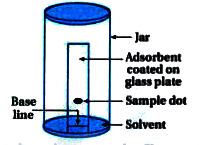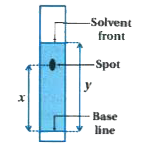Write about thin layer chromatography (TLC)
Text Solution
It is another type of adsorption chromatography in which separation of the components of a mixture is achieved over a thin layer of an adsorbent. Chromaplate or chromatography plate or TLC plate. A thin layer (about 0.2mm thick) of an adsorbent (silica gel or alumina0 is spread over a glass plate of suitable size. The plate is known as thin layer chromatography plate or chromaplate.
Procedure: (i) The solution of the mixture to be separated is applied as a small spot about 2 cm above one end of the TLC plate. (ii) The glass plate is then placed in a closed jar containing the eluant (figure (a)).

Observation: As the eluant rises up the plate, the components of the mixture move up along with the eluant to different distances depending on their degree of adsorption and separation takes place. The relative adsorption of each component of the mixture is expressed in terms of its retardation factor i.e. Rf value.
(i) Distance moved by the substance from base line= (x)
(ii) Distance moved by the solvent from base line =(y)
Rf=xy=Distance moved by the sub. from base lineDistance moved by the solvent from base line
Rf= retardation factor
Rf value of every component is specific.
Note: The Rf of very component in mix solution is different

Identify colour spot and developed chromato gram: (measurement of x): The spots of coloured compounds is called chromatogram hen x is measure only colour spot is present.
(i) The spots of coloured compounds are visible on TLC plate due to their original colour.
(ii) The spots of colourless compounds, which are invisible to the eye but fluoresce, can be detected by putting the plate under ultraviolet light.
(iii) Another detection technique is to place the plate in a covered jar containing a few crystals of iodine. Sports of compounds, which adsorb iodine, will show up as brown spots.
(iv) Sometimes an appropriate reagent may also be sprayed on the plate. For example, amino acids may be detected by spraying the plate with ninhydrin solution.
Derivation: (i) The unknown compound is identify by Rf value (ii) Every spot is separated component of the compound.
|
Topper's Solved these Questions
- ORGANIC CHEMISTRY SOME BASIC PRINCIPLES AND TECHNIQUESBOOK - KUMAR PRAKASHANCHAPTER - ORGANIC CHEMISTRY SOME BASIC PRINCIPLES AND TECHNIQUESEXERCISE - Section -A (Qualitative Analysis of organic compounds)
12 Videos
- ORGANIC CHEMISTRY SOME BASIC PRINCIPLES AND TECHNIQUESBOOK - KUMAR PRAKASHANCHAPTER - ORGANIC CHEMISTRY SOME BASIC PRINCIPLES AND TECHNIQUESEXERCISE - Section -A(Quantitative Analysis)
18 Videos
- ORGANIC CHEMISTRY SOME BASIC PRINCIPLES AND TECHNIQUESBOOK - KUMAR PRAKASHANCHAPTER - ORGANIC CHEMISTRY SOME BASIC PRINCIPLES AND TECHNIQUESEXERCISE - Section A (Fundamental Concepts in Organic Reaction Mechanism)
40 Videos
- HYDROGENBOOK - KUMAR PRAKASHANCHAPTER - HYDROGENEXERCISE - Section-D NCERT Exemplar (Long Answer)
8 Videos
- QUESTION ASKED IN JEE -2018BOOK - KUMAR PRAKASHANCHAPTER - QUESTION ASKED IN JEE -2018EXERCISE - MCQ
10 Videos
Similar Questions
Knowledge Check
Which of the following statements is not true about partition chromatography ?
AStationary phase is a finely divided solid adsorbentB)Separation depends upon equilibration of solute between a mobile and a stationary phaseCPaper chromatography is an example of partition chromatographyDMobile phase can be a gasSelect the wrong statements about chromatography.
AMoving phase is liquid and stationary phase is solidBMoving phase is liquid and stationary phase is liquidCMoving phase is solid and stationary phase is solidDMoving phase is solid and stationary phase is liquidA thin layer of water is transparent but a very thick layer of water is
AtranslucentBopaqueCmost transparentDnone of these
Which of the following statements is not true about partition chromatography ?
View SolutionWhich of the following statements is not true about partition chromatography?
View SolutionWrite the principle of the following :
Chromatography.
View SolutionMethods Of Purification|Sublimation|Crystallisation|Distillation|Chromatography|Column Chromatography|Thin Layer Chromatography|Quiz|Summary
View SolutionA thin layer of water is transparent but a vey thick layer of water is
View Solution
